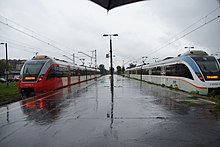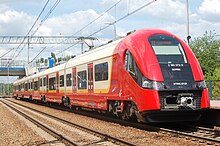Szybka Kolej Miejska (Warsaw)
Szybka Kolej Miejska
History
The earliest attempts to implement an electrified suburban rail system in Warsaw were made in 1936–37, when the Warsaw Railway Junction and surrounding railway lines were electrified to the national standard of 3 kV DC and high platform electric multiple units were introduced (which later came to be designated PKP class EW51).
After World War II, newer EW53, EW54 and EW55 high-platform EMUs were introduced. In 1963, Warszawa Śródmieście railway station was rebuilt into its current form as an underground city station in the city center and in 1967 the Warsaw Cross-City Line was doubled to four tracks to enable separation of suburban and long-distance trains in preparation for the opening of Warszawa Centralna railway station in 1975. The system went into steep decline from the late-1970s due to the country's serious economic problems and the martial law period. These problems persisted well into the 1990s and 2000s as the fall of communism and the country's transition to a market economy made owning private cars more affordable to the general population and as a side effect of decentralization local authorities preferred to invest in infrastructure used directly by their constituencies.
The Warsaw SKM in its current form was proposed in late-2002, stipulating to use the existing infrastructure of the Warsaw Railway Junction, especially the cross city line with its over 2 km long tunnel running under the city center and conveniently located underground station, as a cheap substitute for a badly needed second metro line whose construction did not start until 2010.



In order to implement this the then-
The newly formed company was equipped with six Newag 14WE EMUs which were an extensive modernization of the PKP class EN57 EMUs commonly used on regional routes at the time, with a modern looking body but retaining their original underframes.
A year and a half after being established the SKM initiated its operation with its first trains, opening a single line from Warszawa Zachodnia along the cross city line to Warszawa Wschodnia and along the Vistula river to Warszawa Falenica. The new service failed to deliver on its promise to serve as a viable replacement due to the poor state of the rail infrastructure. Passengers within the city center preferred the more accessible trams system and few people wanted to use the trains in the southeastern districts of the city. Additionally, while the integrated fare system of the Warsaw Transit Authority offered a large convenience the modern look and relative cleanness of the rolling stock sharply contrasted with the standard found in the Polish railroad; during rush hours most of the slots on the tracks were taken up by regional traffic and the new EMUs suffered from the same technical problems as the ones they were based on.
Due to the initial low popularity of the line the original concept was somewhat altered in 2006 with the line extended outside the administrative borders of the city through the Ursus district into the town of Pruszków to the west and diverted to the district of the Wesoła and the town of Sulejówek to the east, turning the service into a suburban commuter network which allowed people in the metropolitan area to quickly reach the city center and conveniently transfer within the city's public transit system. The revised formula proved to be very successful leading the city to take the purchase of all the shares of the company and purchase two more Newag 14WE EMUs. The popularity of trains run the SKM was also instrumental in the city negotiating a deal with the Masovian Voivodeship to have Koleje Mazowieckie honor long term tickets of the Warsaw Transit Authority, first along the route of the SKM and eventually within the entire area served by the city's public transit system.
In 2010 the company purchased four brand new Newag 19WE EMUs and opened a new line to the town of Otwock. Additionally, the Warsaw Transit Authority signed a contract with the Koleje Mazowieckie to operate a line between Warszawa Gdańska station on the Warsaw Circumferential Line and the town of Legionowo under the branding of the SKM, and since 2012 taken over by the company.
In 2011 13 new Pesa Elf 27WE EMUs (2011–2012) were purchased. In 2012 a new airport rail link was created running through the Służewiec office district and a newly opened 1.5 km rail tunnel to Warsaw Chopin Airport.
In 2012 the company purchased 9 six car Newag Impuls 35WE units.[3]
In 2020 SKM has awarded Newag a contract to supply an additional 21 Impuls 2 EMUs, 6 four car versions and 15 with five cars each. The trains feature air-conditioning, a passenger information system, ticket vending machines and validators, Wi-Fi, USB sockets and an AED defibrillator.[4]
In January 2022 Newag has delivered the first two Impuls 2 EMUs [5]
In June 2023, the S4 line was extended to Zegrze Południowe, with two new stations: Wieliszew Centrum and Zegrze Południowe. (note: the Wieliszew Centrum station was not yet completed as of the extension's opening, but was completed later on)
Rolling stock
| Image | Type | Number | Description |
|---|---|---|---|
| Newag 14WE | 2 units | Introduced in 2005. The first six units were purchased with the creation of the company. Rebuilt from old PKP class EN57 and extensively modernized giving them a modern look and making them more suitable for carrying large numbers of passengers on shorter routes within the Warsaw metropolitan area. Two units out of eight originally ordered have been sold to Koleje Śląskie. As of 2022, SKM Warszawa operates only 2 14WE units in the fleet however, they have not run any regular service since June 2022 and are used for substitute services when regular trains break down.[6] | |

|
Newag 19WE | 4 units | Introduced in 2010. New EMUs designed and built for the SKM |

|
PESA 'ELF' 27WE | 13 units | Introduced in 2011. A version of the PESA ELF EMU adapted for the SKM |

|
Newag 35WE | 9 units[7] | Introduced in 2012 |
| Newag 31WEba „Impuls II” | 6 units | Introduced in 2022. A four-car EMU[8] | |

|
Newag 45WEa „Impuls II” | 15 units | Introduced in 2022. A five-car EMU[9][10] |
Lines
As of September 2023 SKM operates 5 regular and 2 temporary lines:[11]
| Line (branch) | From | To | |
|---|---|---|---|
| S1 | A | Pruszków | Otwock |
| B | Warszawa Główna | ||
| S10 | Warszawa Wschodnia | Otwock | |
| S2 | Warsaw Chopin Airport | Sulejówek Miłosna | |
| S20 | Warszawa Wschodnia | ||
| S3 | A | Warsaw Chopin Airport | Radzymin |
| B | Legionowo Piaski | ||
| S4 | Piaseczno | Zegrze Południowe | |
| S40 | Warszawa Rakowiec | ||
S1 line
Pruszków – Otwock
The line was established in October 2005, running from Warszawa Falenica to Warszawa Zachodnia and suspended indefinitely in July 2006 with all of the rolling stock directed to the newly created line S2. In September 2010 the line was re-established and extended towards the town of Otwock, south east of Warsaw, but only reaching Warszawa Wschodnia, which required most of the potential passengers to transfer there to trains running on the line S2 or regional trains operated by Koleje Mazowieckie to reach the city. The line was extended through Warszawa Śródmieście and Warszawa Zachodnia to Pruszków in December 2010.
S1 | |||||||||||||||||||||||||||||||||||||||||||||||||||||||||||||||||||||||||||||||||||||||||||||||||||||||||||||||||||||||||||||||||||||||||||||||||||||||||||||||||||||||||||||||||||||||||||||||||
|---|---|---|---|---|---|---|---|---|---|---|---|---|---|---|---|---|---|---|---|---|---|---|---|---|---|---|---|---|---|---|---|---|---|---|---|---|---|---|---|---|---|---|---|---|---|---|---|---|---|---|---|---|---|---|---|---|---|---|---|---|---|---|---|---|---|---|---|---|---|---|---|---|---|---|---|---|---|---|---|---|---|---|---|---|---|---|---|---|---|---|---|---|---|---|---|---|---|---|---|---|---|---|---|---|---|---|---|---|---|---|---|---|---|---|---|---|---|---|---|---|---|---|---|---|---|---|---|---|---|---|---|---|---|---|---|---|---|---|---|---|---|---|---|---|---|---|---|---|---|---|---|---|---|---|---|---|---|---|---|---|---|---|---|---|---|---|---|---|---|---|---|---|---|---|---|---|---|---|---|---|---|---|---|---|---|---|---|---|---|---|---|---|---|
| |||||||||||||||||||||||||||||||||||||||||||||||||||||||||||||||||||||||||||||||||||||||||||||||||||||||||||||||||||||||||||||||||||||||||||||||||||||||||||||||||||||||||||||||||||||||||||||||||
| Actual as of: 2023-09-29 | |||||||||||||||||||||||||||||||||||||||||||||||||||||||||||||||||||||||||||||||||||||||||||||||||||||||||||||||||||||||||||||||||||||||||||||||||||||||||||||||||||||||||||||||||||||||||||||||||
S2 line
Warsaw Chopin Airport – Sulejówek Miłosna
The line was established in July 2006 running from
S2 | |||||||||||||||||||||||||||||||||||||||||||||||||||||||||||||||||||||||||||||||||||||||||||||||||||||||||||||||||||||||||||||||||||||||||||||||||||||
|---|---|---|---|---|---|---|---|---|---|---|---|---|---|---|---|---|---|---|---|---|---|---|---|---|---|---|---|---|---|---|---|---|---|---|---|---|---|---|---|---|---|---|---|---|---|---|---|---|---|---|---|---|---|---|---|---|---|---|---|---|---|---|---|---|---|---|---|---|---|---|---|---|---|---|---|---|---|---|---|---|---|---|---|---|---|---|---|---|---|---|---|---|---|---|---|---|---|---|---|---|---|---|---|---|---|---|---|---|---|---|---|---|---|---|---|---|---|---|---|---|---|---|---|---|---|---|---|---|---|---|---|---|---|---|---|---|---|---|---|---|---|---|---|---|---|---|---|---|---|
| |||||||||||||||||||||||||||||||||||||||||||||||||||||||||||||||||||||||||||||||||||||||||||||||||||||||||||||||||||||||||||||||||||||||||||||||||||||
| Actual as of:2023-09-29 | |||||||||||||||||||||||||||||||||||||||||||||||||||||||||||||||||||||||||||||||||||||||||||||||||||||||||||||||||||||||||||||||||||||||||||||||||||||
S3 line
Warsaw Chopin Airport – Legionowo Piaski / Radzymin
The line was established in June 2012 connecting the
S3 | ||||||||||||||||||||||||||||||||||||||||||||||||||||||||||||||||||||||||||||||||||||||||||||||||||||||||||||||||||||||||||||||||||||||||||||||||||||||||||||||||||||||||||||||||||||||||||||||||||||||||||||||||||||
|---|---|---|---|---|---|---|---|---|---|---|---|---|---|---|---|---|---|---|---|---|---|---|---|---|---|---|---|---|---|---|---|---|---|---|---|---|---|---|---|---|---|---|---|---|---|---|---|---|---|---|---|---|---|---|---|---|---|---|---|---|---|---|---|---|---|---|---|---|---|---|---|---|---|---|---|---|---|---|---|---|---|---|---|---|---|---|---|---|---|---|---|---|---|---|---|---|---|---|---|---|---|---|---|---|---|---|---|---|---|---|---|---|---|---|---|---|---|---|---|---|---|---|---|---|---|---|---|---|---|---|---|---|---|---|---|---|---|---|---|---|---|---|---|---|---|---|---|---|---|---|---|---|---|---|---|---|---|---|---|---|---|---|---|---|---|---|---|---|---|---|---|---|---|---|---|---|---|---|---|---|---|---|---|---|---|---|---|---|---|---|---|---|---|---|---|---|---|---|---|---|---|---|---|---|---|---|---|---|---|---|---|---|
| ||||||||||||||||||||||||||||||||||||||||||||||||||||||||||||||||||||||||||||||||||||||||||||||||||||||||||||||||||||||||||||||||||||||||||||||||||||||||||||||||||||||||||||||||||||||||||||||||||||||||||||||||||||
| Acurate as of 2023-09-29 | ||||||||||||||||||||||||||||||||||||||||||||||||||||||||||||||||||||||||||||||||||||||||||||||||||||||||||||||||||||||||||||||||||||||||||||||||||||||||||||||||||||||||||||||||||||||||||||||||||||||||||||||||||||
S4 line
Piaseczno – Wieliszew
Line started running on 12 March 2023. It connects city of Piaseczno in south-west with Wieliszew in north-east, running through Warsaw and crossing the Vistula by northern railway bridge. Large stations it stops at are Warszawa Zachodnia (stops at the Platform 9) and Warszawa Gdańska.[13]
S4 | ||||||||||||||||||||||||||||||||||||||||||||||||||||||||||||||||||||||||||||||||||||||||||||||||||||||||||||||||||||||||||||||||||||||||||||||||||||||||||||||||||||||||||||||||||||||||||||||||||||||||||||||||||||||
|---|---|---|---|---|---|---|---|---|---|---|---|---|---|---|---|---|---|---|---|---|---|---|---|---|---|---|---|---|---|---|---|---|---|---|---|---|---|---|---|---|---|---|---|---|---|---|---|---|---|---|---|---|---|---|---|---|---|---|---|---|---|---|---|---|---|---|---|---|---|---|---|---|---|---|---|---|---|---|---|---|---|---|---|---|---|---|---|---|---|---|---|---|---|---|---|---|---|---|---|---|---|---|---|---|---|---|---|---|---|---|---|---|---|---|---|---|---|---|---|---|---|---|---|---|---|---|---|---|---|---|---|---|---|---|---|---|---|---|---|---|---|---|---|---|---|---|---|---|---|---|---|---|---|---|---|---|---|---|---|---|---|---|---|---|---|---|---|---|---|---|---|---|---|---|---|---|---|---|---|---|---|---|---|---|---|---|---|---|---|---|---|---|---|---|---|---|---|---|---|---|---|---|---|---|---|---|---|---|---|---|---|---|---|---|
| ||||||||||||||||||||||||||||||||||||||||||||||||||||||||||||||||||||||||||||||||||||||||||||||||||||||||||||||||||||||||||||||||||||||||||||||||||||||||||||||||||||||||||||||||||||||||||||||||||||||||||||||||||||||
Interchange
| ||||||||||||||||||||||||||||||||||||||||||||||||||||||||||||||||||||||||||||||||||||||||||||||||||||||||||||||||||||||||||||||||||||||||||||||||||||||||||||||||||||||||||||||||||||||||||||||||||||||||||||||||||||||
| ||||||||||||||||||||||||||||||||||||||||||||||||||||||||||||||||||||||||||||||||||||||||||||||||||||||||||||||||||||||||||||||||||||||||||||||||||||||||||||||||||||||||||||||||||||||||||||||||||||||||||||||||||||||
S40 line
Piaseczno – Warszawa Główna
Line started running on 13 March 2023. One train per hour on working days connects the city of Piaseczno with central Warsaw. Trains departure by turns with S4 line.[13]
S40 | |||||||||||||||||||||||||||||||||||||||||||||||||||||||||||||||||||||||||||||||||||||||||||||
|---|---|---|---|---|---|---|---|---|---|---|---|---|---|---|---|---|---|---|---|---|---|---|---|---|---|---|---|---|---|---|---|---|---|---|---|---|---|---|---|---|---|---|---|---|---|---|---|---|---|---|---|---|---|---|---|---|---|---|---|---|---|---|---|---|---|---|---|---|---|---|---|---|---|---|---|---|---|---|---|---|---|---|---|---|---|---|---|---|---|---|---|---|---|
| |||||||||||||||||||||||||||||||||||||||||||||||||||||||||||||||||||||||||||||||||||||||||||||
Interchange
| |||||||||||||||||||||||||||||||||||||||||||||||||||||||||||||||||||||||||||||||||||||||||||||
| |||||||||||||||||||||||||||||||||||||||||||||||||||||||||||||||||||||||||||||||||||||||||||||
Former lines
Line S9 (Warszawa Zachodnia – Legionowo)
The line was established in March 2010, running between
As of 2022, S9 services remain suspended until further notice.
| Station | District/Town |
|---|---|
| Warszawa Zachodnia | Warszawa Wola Warszawa Ochota |
Warszawa Kasprzaka
|
Warszawa Wola |
Warszawa Koło
|
Warszawa Wola |
| Warszawa Gdańska | Warszawa Śródmieście |
Warszawa ZOO
|
Warszawa Praga Północ
|
| Warszawa Praga | Warszawa Targówek |
| Warszawa Toruńska | Warszawa Targówek/Białołęka |
| Warszawa Żerań | Warszawa Białołęka |
| Warszawa Płudy | Warszawa Białołęka |
| Warszawa Choszczówka | Warszawa Białołęka |
| Legionowo | Legionowo |
| Legionowo Piaski | Legionowo |
| Michałów Reginów | Michałów-Reginów |
| Wieliszew | Wieliszew Kolonia |
See also
- Warszawska Kolej Dojazdowa (WKD) - Light rail commuter line in Poland's capital city of Warsaw.
- Koleje Mazowieckie (KM) - Regional rail operator in the Masovian Voivodeship of Poland.
- Polskie Koleje Państwowe S.A. - Dominant railway operator in Poland.
- Polregio - Polish railway operator; formerly Przewozy Regionalne.
References
- ^ a b "Szybka Kolej Miejska w Warszawie │ SKM". skm.warszawa.pl. Archived from the original on 21 March 2023. Retrieved 21 March 2023.
- ^ "About us". Szybka Kolej Miejska. Retrieved 2024-03-12.
Szybka Kolej Miejska is a local railway carrier and one of the elements of Warsaw Public Transport.
- ^ "Newag dostarczył już wszystkie Impulsy dla SKM Warszawa". Archived from the original on 2022-01-17. Retrieved 2022-01-17.
- ^ "SKM and Newag sign $US 160.5m contract for 21 EMUs". 8 April 2020. Archived from the original on 17 January 2022. Retrieved 17 January 2022.
- ^ "First new Newag trains arrive in Warsaw". 14 January 2022. Archived from the original on 17 January 2022. Retrieved 17 January 2022.
- ^ "W Warszawie coraz więcej Impulsów 2. Nie ma już 14WE [aktualizacja]". Archived from the original on 2022-08-27. Retrieved 2022-08-27.
- ^ https://www.skm.warszawa.pl/dla-mediow/galeria/tabor/ezt-35we-impuls/ Archived 2022-01-23 at the Wayback Machine [bare URL]
- ^ EZT 31WEba „Impuls II” Archived 2022-07-17 at the Wayback Machine [bare URL]
- ^ "Pięcioczłonowe Impulsy 2 dla SKM Warszawa pasażerów zabiorą nieco później". Archived from the original on 2022-07-08. Retrieved 2022-07-17.
- ^ "SKM Warszawa czeka na rejestrację ostatnich nowych Impulsów 2". 28 December 2022. Archived from the original on 14 January 2023. Retrieved 14 January 2023.
- ^ "Szybka Kolej Miejska w Warszawie SKM". skm.warszawa.pl. Archived from the original on 2023-07-13. Retrieved 2023-09-29.
- ^ "Rozkłady jazdy – Warszawski Transport Publiczny". wtp.waw.pl. Archived from the original on 2023-07-13. Retrieved 29 September 2023.
- ^ a b "Szybka Kolej Miejska w Warszawie SKM". skm.warszawa.pl (in Polish). Archived from the original on 2023-03-07. Retrieved 2023-03-17.
- (in Polish) Official site Archived 2007-09-28 at the Wayback Machine
